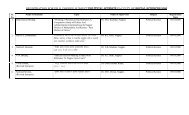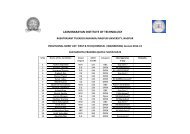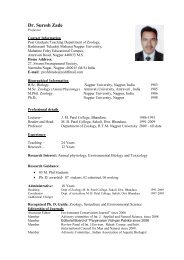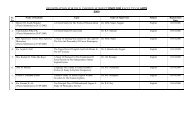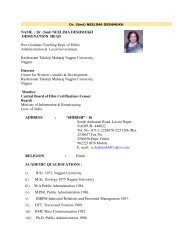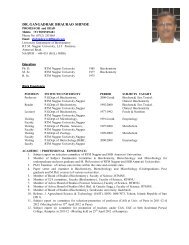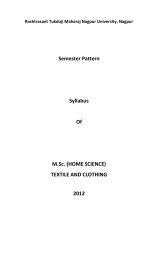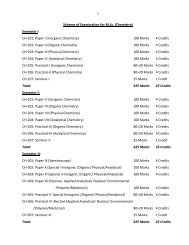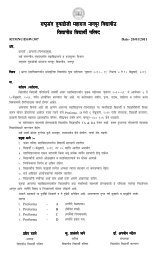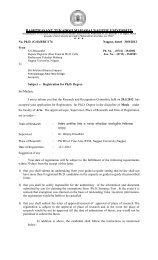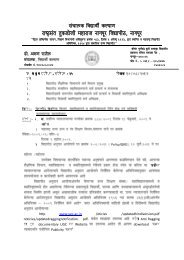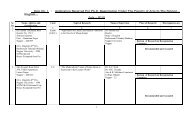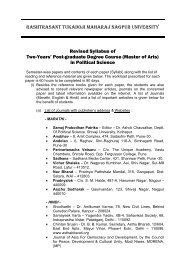Master of Pharmacy - Nagpur University
Master of Pharmacy - Nagpur University
Master of Pharmacy - Nagpur University
Create successful ePaper yourself
Turn your PDF publications into a flip-book with our unique Google optimized e-Paper software.
Syllabus Prescribed for Degree <strong>of</strong> <strong>Master</strong> <strong>of</strong> <strong>Pharmacy</strong> in Pharmaceutics<br />
Semester-I<br />
Subject code: MC-S1<br />
Subject: ADVANCED ANALYTICAL TECHNIQUES<br />
THEORY: 60 Hours (4 hrs. /week)<br />
1. Chromatographic Techniques:<br />
Classification <strong>of</strong> chromatographic methods based on mechanism <strong>of</strong> separation and their<br />
basic principles.<br />
Gas chromatography: Instrumentation, column efficiency parameters, derivatisation<br />
methods, applications in pharmaceutical analysis.<br />
Liquid chromatography: Instrumentation in HPLC, normal and reversed phase<br />
packing materials, column selection, mobile phase selection, efficiency parameters,<br />
applications in pharmaceutical analysis.<br />
Thin Layer Chromatography overview. Instrumentation and applications <strong>of</strong> HPTLC<br />
giving emphasis to use <strong>of</strong> TLC- Densitometry in the standardization <strong>of</strong> some Medicinal<br />
Plants.<br />
Recent advances in Chromatography like LCMS, HPTLC MS, LC MS-MS<br />
2. UV-Visible Spectroscopy:<br />
Basic principles, Instrumentation, Electronic transitions. Concept <strong>of</strong> chromophore and<br />
auxochrome, Effect <strong>of</strong> conjugation, solvent and pH. Instrumentation. Multicomponent<br />
analysis. Woodward-Fieser rules for calculating absorption maximum for unsaturated<br />
hydrocarbons. Difference and derivative spectra. Interpretation <strong>of</strong> spectra, Qualitative<br />
and quantitative analysis <strong>of</strong> drug molecules.<br />
3. Infra-Red Spectroscopy:<br />
Basic principle,Interaction <strong>of</strong> infrared radiation with organic molecules and its effect on<br />
bonds. Instrumentation- Dispersive IR and FT-IR spectrophotometers. Sample<br />
preparation & Sample handling. Interpretation <strong>of</strong> IR spectra. Fermi Resonance. Brief<br />
note on Attenuated Total Reflectance. Qualitative and quantitative applications <strong>of</strong> IR.<br />
4. Nuclear Magnetic Resonance Spectroscopy:<br />
Fundamental principles <strong>of</strong> NMR. Instrumentation. Chemical shift concept, spin-spin<br />
coupling and decoupling, shielding and deshielding, solvents. Pascle triangle, signal<br />
multiplicity in PMR. Spin-spin and spin-lattice relaxation, Nuclear overhauser effect,<br />
Interpretation <strong>of</strong> PMR, 13 C NMR.<br />
5. Mass Spectrometry:<br />
Basic principles and instrumentation. Ionization techniques, mass spectrum and its<br />
characteristics, molecular ion, metastable ions, fragment ions; fragmentation processes,<br />
fragmentation patterns and fragment characteristics in relation to parent structure and<br />
functional groups. Relative abundances <strong>of</strong> isotopes and their contribution to<br />
characteristic peaks.<br />
6. Thermal Methods:<br />
Thermogravimetry, Differential Thermal Analysis (DTA), Differential Scanning<br />
Calorimetry (DSC)<br />
17



